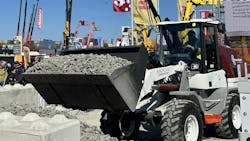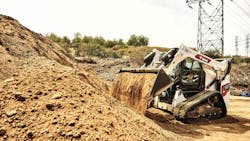Electrification a Key Enabler for Automation in Mobile Machinery
Greater electrification of mobile equipment is increasing the number of electronics incorporated into excavators, wheel loaders and other heavy-duty machinery. This is bringing a range of performance enhancements, including the ability to automate more machine functions.
Electrification Ecosystem Eases Machine Development
Moog Construction offers an ecosystem of components to help mobile equipment manufacturers implement electrification. Doing so helps ease the design process by ensuring all components will work together as desired while also enabling equipment manufacturers to focus on the aspects of machine design they know best.
Technologies in this ecosystem include:
- software controls
- electric cylinders, also known as electromechanical actuators (EMA)
- electric motors, including those for traction and propulsion
- electric motor pump units for driving hydraulic pumps, and
- Adaptive Electrification Management System for simplified power management and control of functions.
Nate Keller, Ph.D., Business Development Manager, Moog Construction, explained that with electrification technologies like those available from Moog, there are integrated sensors and software controls which enable monitoring and control of various machine parameters that can also be used to enable automation.
In this interview with Power & Motion, Keller discusses how Moog’s electrification technologies can help equipment manufacturers implement automation, the role hydraulics will continue to play as well as how he sees automation in the mobile equipment industry continuing to evolve.
*Editor’s note: Questions and responses have been edited for clarity.
Power & Motion: How does Moog’s ecosystem of electrification technologies enable an OEM to add automation to their machine?
Nate Keller: There are two things that you need to have an automated system. You need to have sensors that tell the state of the machine — what position the cylinder, arm or the bucket is at and what pressures these are at — as well as software control to help manage that. Once you have those aspects, it's called a closed loop. Now you're able to do more automation, like automated functions, because now it's all electronically controlled. You are using software to move an arm of an excavator; there's an electronic sensor that is sensing exactly the position of that arm and sending it right back to the software. And it keeps that cycle closed loop, keeps it repeating.
We have encoders on our electric motors so we know at all times the position of the cylinder, and we also have the machine kinematics put on a controller. Between knowing the position of cylinder and the kinematics, we know exactly what position the boom is in, or the bucket or the swing on an excavator, we know all of these things and it's all controlled through software and electronics. So, if it's all controlled through software and electronics, we don't need to do any physical tuning to valves. Normally, you have to throttle your valves, and there's a lot of in-depth design involved in determining exactly how your valve is going to behave, to get the feel and the speed and performance of your actuator on your machine. Well, now that's all 100% software controlled. There's no more physical changing of a valve — how it's cut, how it throttles — now it's all software. So now if you want to change how a machine operates, it's all through software. And since it has that closed loop control, we can automate those functions because we're sensing it and we're controlling it.
Power & Motion: When developing systems to enable automation capabilities, what are some of the key design considerations that need to be kept in mind?
Nate Keller: This is very much up to the original equipment manufacturers (OEM) and, more specifically, what their customers want. It really depends on the type of machine, the size of the machine, and its application. For example, a full-electric CTL (compact track loader) or skid steer may not, at this moment, be required to be fully autonomous. These are general purpose machines, and autonomous doesn't look like it's there yet for the full market. However, there are applications where it does make sense. For instance, in underground mining, a full-electric machine is more productive, as well as costs less for a mine for operating expenses. But it also is in a very controlled environment doing a repeated task, and so automation would make more sense to go into that particular application. Whereas a general purpose skid steer, it's being used in so many different ways, so many different environments and autonomy is not going to really make much sense for that application. So, that's what needs to be kept in mind — what’s the application? What's the machine type and what's the size of the machine? Now, that's for full autonomy.
Automated features, I think, can be applied to any machine and any size. It just depends on what the feature is. On a wheel loader, for example, on a production size wheel loader that's main job is truck loading and moving material, if it's doing the same [task such as] what's called a y-cycle — trucks keep pulling up to the same spot, and it keeps dumping into the trucks – the operator could just record a cycle where he drives into pile, breaks out, backs up, and goes and dumps in the truck, he could record that whole operation and then just hit a play button and it does it automatically. It's automating those features while not being fully autonomous.
Moog Construction solutions are ready for full autonomous operation when the market is ready. But it has, as of now, feature automation that's also ready whenever anybody needs it…that's one of the benefits, it's called future proofing. If they want it in 5 or 10 years from now, they've already got a system designed to have that; they [OEMs] don't have to go and redesign everything and then redeploy everything. They can just send it [an update] out over the air and have automation.
Read "Bobcat Focused on Developments in Connectivity, Electrification and Automation" for our interview with Joel Honeyman, Vice President of Global Innovation at Bobcat Co., to learn how the OEM — which has worked with Moog on its electrification development efforts — is working to bring automation to the construction industry.
Power & Motion: Given Moog’s electrification ecosystem is comprised of so many electronic components, do you see a shift toward increased use of electronics to achieve automation? What role do you see hydraulics continuing to play as automation increases?
Nate Keller: That's where a lot of questions have been coming up. Is it going to be full electric? Quite a few people don't see that as a possibility. I'm in the mixed camp. I really believe that there will be full electric for some applications, as well as some OEMs; it's what they really believe and they are committed to.
But then when you're looking at electric-hydraulic…hydraulics are not going away, particularly in the larger segments, they just have a power density that is very hard to beat, and a cost that's hard to beat. As you get to these really large machines, if you were to go to a full-electric cylinder, it would be very cost prohibitive compared to some of the smaller compact size [machines] as well as there being some of packaging constraints and difficulties.
Hydraulic is not going to go away; it's just going to be used more efficiently, and it's going to be designed so that its performance is increased. That performance [and] efficiency increase will be achieved through an increase in electronic usage. [There are different phases of electrification] — Phase 1 is simple electrification with just one electric motor. Phase 2 is to increase the performance of the machine and increase its efficiency. Well, to do that, you need more electric motors. And to have more electric motors, you need more drives, and you need more control. With hydraulics, depending on what the application requires, you would need some additional sensors as well. I don't think it's debated that the future of the off-highway industry, the future of hydraulics is going to be more electronic. What is a little bit more of a hot topic is how that's going to look.
Power & Motion: How does Moog Construction see automation in the construction and other mobile equipment industries continuing to evolve?
Nate Keller: Automation is a difficult market to predict. Certainly, there's more automated features that I believe are going to be utilized more and more. And then there's some industries, like the mining industry, that have been using automation for quite a long time. But as far as the construction industry, I see it more as an incremental increase. As you start getting more automated features, eventually it will reach a level where autonomy would come into play. But there's still so much unknown about how that market is going to be, what the market needs are for autonomy, as well as a big question around how to ensure that everything is safe.
The industry is still working on developing standards for the safety of autonomous machines. In the next 3 years, I see a few automated features increasing and then full autonomy in certain applications; I could certainly see [full autonomy] in the next 5-10 years. But in the near term, it is harder to see full autonomy come to realization in this particular market. There are applications, like I mentioned in underground mining, that it could work, but generally speaking, I think it'll be an incremental shift.
About the Author
Sara Jensen
Executive Editor, Power & Motion
Sara Jensen is executive editor of Power & Motion, directing expanded coverage into the modern fluid power space, as well as mechatronic and smart technologies. She has over 15 years of publishing experience. Prior to Power & Motion she spent 11 years with a trade publication for engineers of heavy-duty equipment, the last 3 of which were as the editor and brand lead. Over the course of her time in the B2B industry, Sara has gained an extensive knowledge of various heavy-duty equipment industries — including construction, agriculture, mining and on-road trucks —along with the systems and market trends which impact them such as fluid power and electronic motion control technologies.
You can follow Sara and Power & Motion via the following social media handles:
X (formerly Twitter): @TechnlgyEditor and @PowerMotionTech
LinkedIn: @SaraJensen and @Power&Motion
Facebook: @PowerMotionTech

Leaders relevant to this article:




